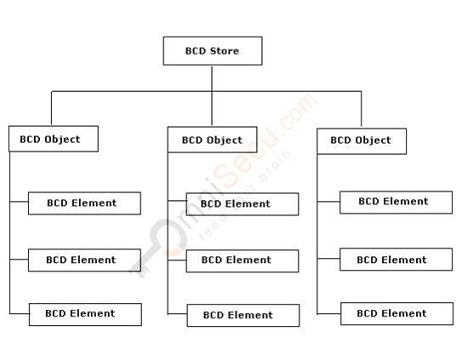Boot Configuration Data (BCD) Architecture
The Boot Configuration Data (BCD) Architecture is a hierarchy consisting of three basic components. They are BCD Stores, BCD Ojects, and BCD Elements.

BCD Store : BCD Store is the top level component in the hierarchy. BCD Store serves as a namespace container for the BCD objects and BCD elements.
BCD Object: BCD Object is a container for all BCD elements. The most common type of BCD object describes a boot environment application, such as an instance of the Windows boot loader.
BCD Element: BCD Element is a singular item of data like, a boot application name, or an operating system device.
Following are some important BSD Objects.
Windows boot manager object: There is one Windows boot manager object which contains BCD elements related to the Windows boot manager, such as the entries to display in an operating system selection menu, boot tool selection menu, and timeout for the selection menus. Windows boot manager object can be considered as the [boot loader] section of the original boot.ini file.
Windows boot loader objects: BSD Stores contain one instance of this object for each Windows Server 2008 Operating Systems that is installed on the system. Windows boot loader objects contain BCD elements that are used when loading Windows or during Windows initialization such as no-execute (NX) page protection policy, physical-address extensions (PAEs) policy, kernel debugger settings etc.
Windows NTLDR. Windows NTLDR are optional special object points to the old NTLDR if you have an older Windows installation on the system.
Optional boot applications: Optional boot applications are special applications perform other boot related tasks. Example is Windows Server 2008 Memory Diagnostic tool, an optional boot application used to perform various memory checks on the system.
Following table decribe boot.ini to BCD mapping.